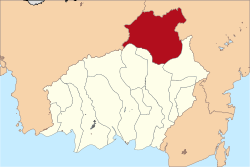- Murung Raya Regency
-
Murung Raya Regency — Regency — 
SealMotto: Tira Tangka Balang Location of Murung Raya within Central Kalimantan Coordinates: 1°24′30″S 115°8′0″E / 1.40833°S 115.133333°E Country Indonesia Province Central Kalimantan Capital Puruk Cahu Government – Regent Area – Total 38,617 km2 (14,910.1 sq mi) Highest elevation 1,730 m (5,676 ft) Lowest elevation 100 m (328 ft) Population (2010 Census) – Total 97,029 – Density 2.5/km2 (6.5/sq mi) Time zone WIB (UTC+7) Website kabmurungraya.go.id Murung Raya Regency is the most northerly of the thirteen regencies (districts) which comprise the province of Central Kalimantan on the island of Borneo, Indonesia. The capital of the district is Puruk Cahu. Prior to the 2002 reorganization, this district was a division of the North Barito Regency. The district had a population of 97,029 inhabitants at the 2010 Census.
Contents
Subdivisions
This district consists of 10 sub-districts (divisions), 124 villages and 9 villages:
- Murung
- Tanah Siang
- Laung Tuhup
- Permata Intan
- Sumber Barito
- Sungai Babuat
- Tanah Siang Selatan
- Barito Tuhup Raya
- Seribu Riam
- U’Ut Murung
Geography
The district has an area of 38,617 km² and it lies between 114°27'00 to 115°49'00 East longitude and 0°58'30 North latitude to 1°26'00 South latitude. It occupies the valleys and foothills of the southern slopes of the and the eastern slopes of the Müller Mountains, and rises to 1730 m. at Mount Lesung on it northern border. Most of the riverine area lies at an altitude of 100 to 200 m above sea level while the foothills are mostly at an altitude of 400-500 m.
The Betikap and Sepathawung valleys, in the northwest part of the district have been declared protected areas for orangutans.[1] The Tumbang Topus caves have been the source of discovery of a number of new species.[2]
Economy
Most of the population lives along rivers and relies on them for transportation, food, and agriculture. Aside from the predominant subsistence fishing and farming, the biggest contributors to the economy are forestry and mining. Timber, including high value trees such as Ulin (Eusideroxylon zwageri) and Meranti (genus Shorea), has been commercially extracted since the 1920s, while the mining sector, such as gold and tin mining, has developed since World War II. In the 1990s coal exploration began, and in the 2000s the Haju coal mine started to be developed.[3]
Notes
- ^ Staff (15 April 2007) "1000 Orangutans to be released into the wild" Wildlife Extra News
- ^ Staff (16 September 2010) "LIPI discovers four new species of whip-spiders" Antara News
- ^ Staff (13 September 2007) "PT Lahai Coal Investing US$68 mln in Haju Block, C Kalimantan" AsiaPulse News
External links
Regencies and Cities of Central Kalimantan Capital: Palangka RayaRegencies South Barito • East Barito • North Barito • Gunung Mas • Kapuas • Katingan • West Kotawaringin • East Kotawaringin • Lamandau • Murung Raya • Pulang Pisau • Sukamara • Seruyan

Cities Categories:- Regencies of Central Kalimantan
Wikimedia Foundation. 2010.

